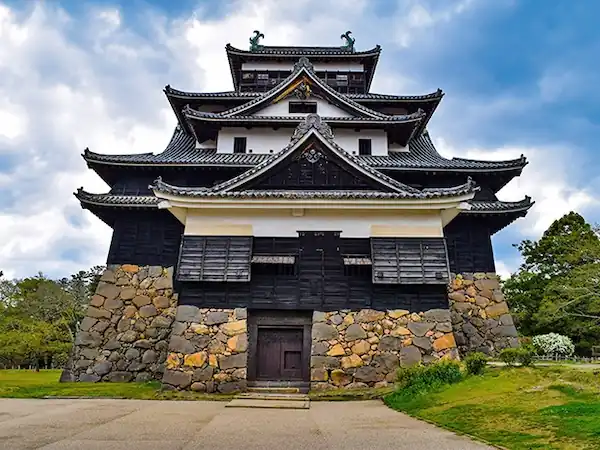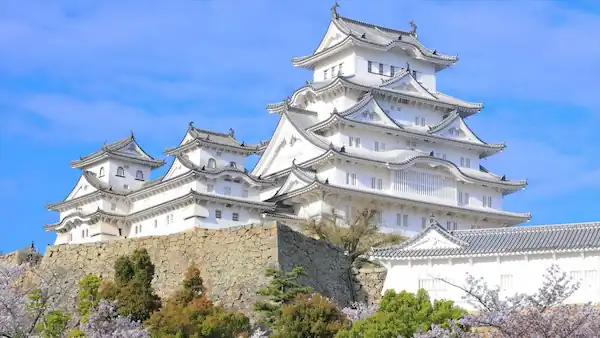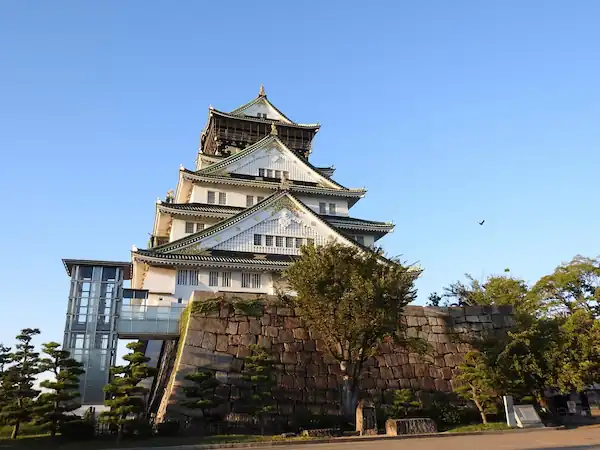The Importance of Castles to the Japanese People
Soaring majestically over the Japanese landscape, castles are far more than mere fortresses or historic structures.
They are potent symbols of Japan’s history, culture, power, and artistry, captivating people both domestically and internationally across the ages.
Numerous castles dot the nation, each holding its own unique story.
This article delves into the multifaceted roles Japanese castles have played, their astonishing construction methods, intricate structures, and their significance in the modern era, aiming to deepen our general knowledge of these incredible edifices.
Furthermore, we will briefly introduce five particularly renowned castles – Matsue, Himeji, Osaka, Hikone, and Inuyama – inviting you into the profound world of Japanese castles.
Please bear in mind that these five are merely examples, and Japan is home to many other fascinating castles well worth a visit.Japanese castles undertook diverse roles corresponding to their historical context and societal conditions.
They functioned not just as military strongholds but also as political, economic, and cultural centers, contributing significantly to regional development.
Table of Contents
The Roles of Castles: More Than Just Fortresses
Castles as Military Strongholds
Especially during turbulent periods like the Sengoku (Warring States) era, the most crucial role of a castle was the defense of territory and a base for governance.
Samurai and feudal lords (daimyo) resided within, and castles functioned as formidable bastions against enemy invasion.
Consequently, they were invariably built in strategic locations offering good visibility and defensibility.
Defensive structures like castle walls, moats, turrets (yagura), and the main keep (tenshu) were essential elements for repelling enemy attacks and gaining an advantage in siege warfare.
Castles as Political and Economic Centers
Castles were also the administrative hubs for governing territories.
Daimyo conducted politics, issued laws, and collected taxes from their castle base.
The presence of a castle attracted people to its surroundings, promoting the formation of castle towns (jōkamachi).
These castle towns became hubs for commerce, industry, and culture, driving regional economic development.
The evolution of castles from purely military facilities to entities with broader socio-economic functions marks an important turning point in Japanese history.
As the incessant conflicts of the Warring States period ended and the relatively peaceful Edo period began, the role of castles shifted.
While daimyo still needed to demonstrate their authority, their focus gradually moved towards managing their domains and promoting culture.
Castles as Symbols of Power and Authority
The grandeur of a castle, particularly the imposing majesty of its keep, visually represented the power, wealth, and cultural sophistication of its lord.
Soaring keeps and solid stone walls were intended to flaunt the lord’s authority and inspire awe not only among the local populace but also among other daimyo.
For example, Osaka Castle, built by Toyotomi Hideyoshi, aimed to surpass the scale of Azuchi Castle (built by his lord, Oda Nobunaga), serving as a prime example of his ambition and power as a unifier of Japan.
Castles as Cultural Hubs
Castles and their surrounding towns also became venues where art and culture flourished.
Various cultural activities such as the tea ceremony, waka poetry, and martial arts were encouraged and developed within and around the castle.
The daimyo culture of the Edo period and the prosperity of castle towns, in particular, can be said to have formed with the castle at their center.
Thus, Japanese castles were unique entities that fused practical functions (defense, governance) with deep symbolism (power, culture, the samurai spirit), extending beyond mere military installations or political centers.
This duality is one reason why Japanese castles continue to fascinate people across time.
Castle Construction: The Ingenuity of Master Craftsmen
The construction of Japanese castles involved the highest technology of the time and the labor of countless individuals.
Particularly noteworthy are the construction of stone walls (ishigaki) and moats, and the erection of wooden buildings that were pinnacles of architectural skill.
Stone Walls (Ishigaki): Foundations of Defense and Dignity
Stone walls are one of the most distinctive features of Japanese castle architecture, symbolizing the lord’s authority while serving a defensive function.
- Stonewalling Techniques

There are several methods of stone wall construction.
Nozurazumi, using natural, unworked stones, is seen in older forms or less critical areas.
Matsue Castle’s stone walls employ this technique.
Uchikomihagi, where stones are hammered at their joints to reduce gaps, is a more advanced method, also adopted at Matsue Castle.
Finally, Kirikomihagi, where stones are precisely cut into squares and stacked without gaps, represents the most sophisticated technique, resulting in a beautiful finish.
The evolution of these techniques not only shows advancements in stonemasonry but also reflects a growing aesthetic awareness alongside improvements in defensive capabilities, aligning with the changing roles of castles. - Slope and Design

The slope of stone walls, known as ōgi no kōbai (fan-shaped slope), was sometimes designed with a gentle curve at the base that became steeper towards the top, balancing climb-resistance with stability – a testament to advanced civil engineering.
Furthermore, enormous stones were placed in prominent locations like the main castle entrance (Otemon) to display authority.
Features like ore (angles) or yugami (distortions) were incorporated into the stone walls, creating angles from which defenders could fire upon enemies attempting to scale the walls (a technique called yoko-ya-gakari, or side-firing).
Osaka Castle’s massive stone walls are a prime example. - Construction Process
The overall civil engineering work, including the creation of stone walls and moats, was called fushin. It often involved vast numbers of laborers in a human-wave effort, alongside specialized groups of artisans like stonemasons.
Remarkably, in an era without cranes or heavy machinery, they transported and stacked enormous stones.
Various ingenious methods were employed, such as using logs as rollers, utilizing pulleys and ropes, and building dedicated paths for stone transportation.
Records show that for Matsue Castle’s construction, three of the total five years were spent on stone wall fushin, indicating the immense labor and high level of technical skill involved.
The construction of such massive structures under these challenging conditions demonstrates a deep practical understanding of physics and engineering, as well as advanced planning and organizational capabilities
Moats (Hori): The First Line of Defense
Moats were indispensable defensive features, and the excavated earth was often piled up to form earthen ramparts (dorui) for further defense.
There were water-filled moats (mizubori) and dry moats (karahori).
- Types of Moats

Various types of moats were created depending on topography and strategy.
Tatebori were vertical moats dug into mountain slopes to hinder enemy lateral movement.
There were V-shaped yagenbori, box-shaped hakobori, and shōjibori, which had complex ridged bottoms, famously used in Hojo clan castles (e.g., Yamanaka Castle).
These diverse moat designs were not mere ditches but were conceived to anticipate enemy invasion routes and tactics, demonstrating that castle engineers of the time possessed advanced knowledge of siege and defense.
Wooden Architecture: The Technology of Keeps and Turrets
The main parts of castle architecture, such as keeps, turrets (yagura), and gates, were wooden.
Carpenters of the time utilized sophisticated joinery techniques (mortise and tenon, known as tsugite and shikuchi) to assemble timber with few or no nails, creating multi-story buildings that were both strong and flexible enough to withstand natural disasters like earthquakes and typhoons.
During periods of intense castle construction when building materials were often scarce, ingenious methods were employed to maximize resources, such as effectively using short pillars or using special woods like paulownia (kiri) (known for its fire-retardant and rot-resistant properties) for specific rooms.
Matsue Castle’s paulownia staircase is one such example.
Castle Structure: Calculated Spatial Beauty and Defensive Functionality
The structure of Japanese castles is not merely robust; it exhibits ingenious designs throughout to deceive enemies and effectively repel them.
The beautiful fusion of aesthetics and functionality is a key characteristic.
Bailey Layout (Kuruwa) and Fortification Design (Nawabari)
The central part of the castle, the main bailey (honmaru), and the surrounding second (ninomaru) and third (sannomaru) baileys are called kuruwa. Strategically arranging these sections, often in concentric circles or terraced layouts (teikakushiki) according to the terrain, is known as nawabari.
Each bailey was separated by moats, stone walls, and earthen ramparts topped with plaster walls, forming phased defensive lines.
Pathways into the castle were intentionally made complex and winding with poor visibility to confuse intruders and slow their advance.
This was designed to make the castle itself function as a kind of labyrinth, aiming for the psychological oppression and tactical confusion of enemy soldiers.
Such spatial design reflects the idea of “dynamic defense” – not just static defensive walls, but a system to control enemy movement and guide them to specific points for annihilation.
The Keep (Tenshu): Castle Symbol and Final Stronghold
The keep was the tallest, most prominent structure within the castle, symbolizing the lord’s authority and serving as the final command post and defensive bastion during wartime.
Early keeps evolved from watchtowers (bōrō), but as time went on, they acquired more magnificent and ornate appearances.
This is related to the shift in the keep’s role from a practical combat base to a symbol of the daimyo’s authority and status, as large-scale battles decreased with the advent of the Edo period.
The roofs of keeps featured various types of gables (hafu), which served both decorative and practical purposes (for installing arrow slits, sama, or stone drops, ishi-otoshi).
Hikone Castle’s keep is known for its beautiful appearance, combining various gables such as kirizuma-hafu (gable roof), irimoya-hafu (hip-and-gable roof), chidori-hafu (decorative gable), and karahafu (cusped gable).
Turrets (Yagura) and Gates (Mon): Key Defensive Points
Turrets were built atop castle walls or at the corners of baileys, functioning as observation posts, armories, troop stations, and platforms for flanking attacks.
Many turrets, like Osaka Castle’s Sengan Yagura and Inui Yagura, are themselves important cultural properties.
Gates were the entrances and exits to the castle and were among the most heavily fortified points.
Major gates, especially the main gate (Otemon), often had a masugata structure – a box-like enclosure designed to trap and surround attacking enemies.
Osaka Castle’s Otemon is a typical example. Tamon-yagura, long, barrack-like turrets built on top of stone walls, also served as defensive ramparts.
Castles in the Modern Era: Cultural Heritage Preserving History
Once stages for conflict and symbols of power, Japanese castles have acquired new value in the modern era and are cherished by many.
Protection and Preservation as Cultural Properties
Many castles and their remains are designated as National Treasures (e.g., Himeji Castle, Matsue Castle, Hikone Castle, Inuyama Castle), Important Cultural Properties (e.g., many structures within Osaka Castle), or Special Historic Sites (e.g., Himeji Castle), and are protected as vital national cultural heritage.
To pass these castles down to future generations, extensive preservation and restoration work (such as Himeji Castle’s “Great Shōwa Restoration” and numerous repairs to Osaka Castle’s structures) has been carried out over many years.
Many castles, like Matsue Castle and Himeji Castle, which miraculously survived the ravages of World War II, or Hikone Castle, which avoided demolition under the Meiji era’s Castle Abolition Edict thanks to an imperial decree, remain today due to good fortune and human effort.
The significant investment and labor in their preservation and restoration testify to the high societal value placed on castles not merely as old buildings but as irreplaceable heritage deeply tied to national and regional identity.
Tourist Attractions and Contributions to Local Regions
Existing castles and castle ruins are major tourist attractions, drawing numerous visitors from Japan and abroad.
Visiting a castle offers a valuable experience of Japanese history and culture and contributes to local economic revitalization.
Moreover, castles serve as regional landmarks and are objects of pride and affection for local residents.
Role as Educational Venues
Castles serve a crucial role in learning about history, architecture, and culture as “living textbooks” that concretely illustrate the past.
Museums established within castles (such as the historical museum inside Osaka Castle’s keep) display related artifacts and armor, helping visitors gain a deeper understanding of the historical context.
Symbols of the Samurai Spirit and Japanese Identity
For some, castles are still perceived as symbols of the samurai spirit (bushidō), loyalty, and military strategy.
>>For more information on Bushido, click here: What is Bushido?: The Spirit of Bushido Seen in Modern Japan
The beauty of Japanese castle architecture and its historical significance are recognized as part of Japan’s world-class cultural heritage.
Himeji Castle’s registration as a UNESCO World Heritage site clearly demonstrates its international value.
In recent years, modern uses of castles have emerged, such as the creation of lists like “Japan’s Three Great Castles” or the “Five Great Castles” in this article, and the appearance of mascot characters like Hikone Castle’s “Hikonyan.”
These can be seen as attempts to dynamically link respect for history with contemporary cultural promotion, attracting the interest of new generations to historical heritage.
Such initiatives play an important role in positioning castles not merely as static historical sites but as living, evolving cultural heritage within contemporary society.
Explore! Japan’s Five Great Castles
Here, we briefly introduce five castles particularly renowned for their historical value and architectural beauty from among Japan’s many famous castles.
We plan to delve deeper into the specific charms of each castle in future articles.
For now, please enjoy a glimpse of the unique character these castles possess.
| Castle Name | Location | Key Features | Brief Introduction |
| Matsue Castle | Matsue, Shimane | National Treasure keep, only “authentic” keep among 12 existing, irimoya gables | Black majesty in a waterside setting; a robust, practical castle built for war. |
| Himeji Castle | Himeji, Hyogo | National Treasure keep, World Heritage Site, “White Heron Castle” | Shimmering white walls, the pinnacle of Japanese wooden architecture. |
| Osaka Castle | Osaka City, Osaka | Reconstructed keep, giant stone walls, many Important Cultural Properties | Toyotomi Hideyoshi’s dream; a castle of rulers with a turbulent history. |
| Hikone Castle | Hikone, Shiga | National Treasure keep, diverse gables, gobōzumi stone wall technique | Reflects the Ii clan’s governance; a beautifully designed castle of varied charm. |
| Inuyama Castle | Inuyama, Aichi | National Treasure keep, oldest existing style, watchtower-style keep | Overlooking the Kiso River, an ancient castle conveying the Sengoku spirit. |
Matsue Castle (Shimane Prefecture): The Dignity of an Original Keep and Lakeside Scenery
Matsue Castle’s keep is said to be the only “authentic keep” among the 12 remaining original keeps in Japan that most faithfully conveys its original form at the time of construction.
Completed in 1611, it was designated a National Treasure in 2015.
Its exterior is characterized by elegant irimoya-hafu (hip-and-gable roofs) resembling a plover spreading its wings, unique katōmado (cusped windows), and Japan’s largest wooden shachihoko (mythical fish-like roof ornaments) still in existence.
The stone walls are solidly constructed using nozurazumi (unworked stones) and uchikomihagi (partially worked stones). Internally, one can see the wisdom and skill of the craftsmen of the time in its robust, practical design intended for real combat, including stairs made of paulownia wood (for fire and rot resistance) and structures that cleverly utilized short pillars during an era of timber scarcity.
Its black silhouette soaring above the beautiful waterside scenery overlooking Lake Shinji truly exudes an imposing dignity.
The “Matsue Horikawa Meguri,” a boat tour around the castle moats, is also a popular tourist experience.

Photo by: Matsue Castle
Himeji Castle (Hyogo Prefecture): The Elegance of a White Heron and World-Renowned Castle Architecture
Himeji Castle, affectionately nicknamed “Hakuro-jō” or “Shirasagi-jō” (White Heron Castle) due to its beautiful white plaster exterior, was Japan’s first UNESCO World Heritage site, registered in 1993.
Its main structures, including the grand keep, are also designated National Treasures.
Considered a masterpiece of early 17th-century Japanese castle architecture, its “aesthetic perfection” is highly acclaimed worldwide.
Centered around a complex of linked keeps, its turrets, gates, earthen walls with plaster, and ingeniously arranged stone walls and moats are preserved in excellent condition, conveying Japan’s uniquely advanced defensive systems to the present day.
Its grand scale and complex, intricate structure overwhelm visitors.
The philosophy behind Himeji Castle’s preservation and restoration has even influenced international discussions on the authenticity of cultural properties (e.g., the “Nara Document on Authenticity”), and its cultural-historical significance is immeasurable.

Photo by: Himeji City
Osaka Castle (Osaka Prefecture): Toyotomi Hideyoshi’s Dream and the Vicissitudes of a Unifier’s Castle
Osaka Castle was begun by Toyotomi Hideyoshi in 1583 and later rebuilt by the Tokugawa Shogunate, playing an extremely important role in Japanese history.
Although the current keep is a reconstruction from the early Shōwa period (1926-1989) funded by citizen donations, many turrets, gates, and the Enshōgura (gunpowder magazine) from the Tokugawa era, such as the Otemon (main gate), Sakuramon gate, Sengan Yagura, Inui Yagura, and Rokuban Yagura, remain as Important Cultural Properties.
In particular, the massive stone walls fortifying the castle are breathtaking, including some of Japan’s largest megaliths, such as the “Tako-ishi” (Octopus Stone), which attest to the power and technical prowess of the daimyo involved in its construction.
It was also the tragic stage for the fall of the Toyotomi clan (the Siege of Osaka), and its subsequent history of repeated destruction by fire and reconstruction can be said to be a microcosm of Japan’s power struggles.

Photo by: Psaka Castle Park
Hikone Castle (Shiga Prefecture): National Treasure Keep and a Famous Castle Conveying the Ii Clan’s History
Hikone Castle’s keep, designated a National Treasure, is characterized by its richly varied roof design.
Construction was started in the early Edo period by Naotsugu and Naotaka, sons of Ii Naomasa, one of Tokugawa Ieyasu’s four most trusted generals.
It remained the seat of the Ii clan, leading fudai daimyo (hereditary vassals of the Tokugawa), until the end of the Edo period.
The keep skillfully combines diverse gables such as kirizuma-hafu, irimoya-hafu, chidori-hafu, and karahafu, creating a beautiful appearance that changes with the viewing angle.
The stone walls of the keep’s base employ a special technique called gobōzumi (burdock piling), where long, slender stones are deeply embedded.
Other structures, like the West Bailey Three-Story Turret and the Taikomon Yagura (Drum Gate Turret), are extant Important Cultural Properties, and the entire castle grounds are designated a Special Historic Site.
In recent years, it has also become known for its mascot character, “Hikonyan,” and there are movements to have it registered as a World Heritage site.

Inuyama Castle (Aichi Prefecture): National Treasure Keep Boasting the Oldest Existing Style
Inuyama Castle’s keep is said to possess the oldest existing style among Japan’s extant keeps and is designated a National Treasure.
It is traditionally believed to have been built in 1537 by Oda Nobuyasu, an uncle of Oda Nobunaga.
The keep is of an early “watchtower style” (bōrō-gata), with a three-story, four-level structure (plus two basement levels) featuring a watchtower placed atop a two-story turret.
Built on a small hill on the south bank of the Kiso River, the top-floor balcony (mawari-en) offers a spectacular panoramic view of the majestic Kiso River below and the Nōbi Plain.
It is also nicknamed “Hakutei-jō” (White Emperor Castle), likening it to a castle of the same name in China’s Yangtze River basin.
During the Edo period, the Naruse clan served as castle lords, and it has an unusual history of being privately owned from the Shōwa to the Heisei era (1926-2019).
It is a precious ancient castle that strongly retains the atmosphere of the Warring States period.

Photo by: Inuyama Castle
To the Profound World of Japanese Castles
Japanese castles are not mere relics of the past.
They are witnesses to history, crystallizations of the wisdom and technology of our ancestors, and powerful cultural symbols that still speak to our hearts today.
The five castles introduced in this article are but a small glimpse into the magnificent and profound culture of Japanese castles.
The unique history, stories, and beauty of each castle can only be truly experienced by visiting them in person.
It feels as though the breath of former samurai and the lives of the people in the castle towns are etched into every stone of the walls, every pillar, and even in the sound of the wind that blows around the castle.
These castles convey to us the dynamism of Japanese history, teach us the marvels of architectural technology, and allow us to feel the richness of regional cultures.
We encourage you to visit these castles, and the many other fascinating castles dotted throughout Japan, to experience their grand scale, intricate beauty, and the human thoughts and feelings embedded within them. A journey through Japan’s castles will surely satisfy your intellectual curiosity, deepen your understanding of Japanese history and culture, and become an unforgettable experience.
If you listen carefully to the voices the castles impart, you should be able to hear stories that transcend time.
Reference Sites
- Inuyama City: https://www.city.inuyama.aichi.jp/shisei/shokai/1005454/1005973.html
- Matsue Castle Official Site: https://www.matsue-castle.jp/highlight/history
- Himeji Castle Official Site: https://www.city.himeji.lg.jp/castle/0000007744.html
- Osaka Castle Park Official Site: https://www.osakacastlepark.jp/model_cource/cultural_property.html?lang=ja






Leave a Reply